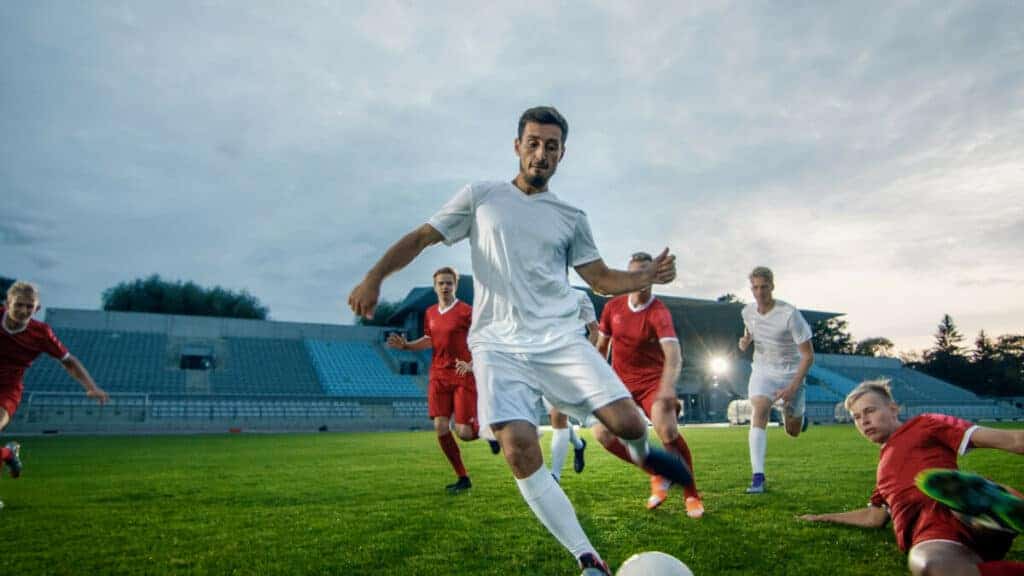How many soccer players are on the field
If you’re new to soccer, you may be curious about how many players total are on the field, as well as how many people are on each team. Well, you’ve come to the right place. We’ll go over all you should know about the number of soccer players, substitutions, and positions.

In total, there are 22 soccer players on a soccer field, with 11 players on each team. The number of players can differ between young age groups, but any field with players over 12 years old will have 22 players. This number doesn’t count any substitutes, of which each team can have up to 5.
To learn more about how many people are required to make a soccer game work, as well as what the positions are, continue reading.
Ideal, minimum, and maximum number of players on a soccer field

While 22 is the ideal number of players on the field at once for a soccer game, there are a minimum and a maximum number of players for a game to be able to work smoothly. The ideal number of players on each team is 11 because that is the total number of positions there are. This does not include teams with children under 12 years old.
Because 11 is the number of different positions that are distributed to each player on the team, a team cannot have more than 11. If a team has more than 11 players, there won’t be any more positions, nor the responsibilities that come with those positions, to give to those extra players. That said, a field cannot have more than 22 players on a field.
Having too many players on a team can create a lot of confusion and chaos on the field that will prevent a successful and smooth game from playing out. Any extra players must instead sit out on the bench next to the field and serve as substitutes. If any of these substitutes enter the field without being told to do so by the coach, the coach will have to stop the game until the extra player is off the field and is no longer throwing off the game.
While a game cannot have more than 11 players per team, a game can still go on if there are as few as 7 players per team. 7 is the minimum amount of players per team, and 14 is the minimum amount of players that can be on the field at once unless the group of players is younger than 12 years old. If there are 7 players per team, then the players will be assigned positions #1 through 7, and so on if there are more than 7 players. The more players there are in a team, the better the team can work together to defeat the other team, and both teams must always have an equal number of players.
Number of players for each age group

As mentioned above, having 11 players per team and therefore 22 players on the field is applicable to any team with players over 12 years old. For teams with players under 12 years old, the number of players can differ.
The reason that younger teams have fewer players is that while the young players are still learning, it will be easier for them to grasp how a game works if there are fewer players, and it will make it easier for the young players to concentrate without getting distracted by everything else going on.
Keep in mind that the number of players for each age group can be more than the number given in the table, but no more than 11, but this is the recommended number for each age group. For each team, regardless of the number of players, the positions are assigned in ascending order, so if there are 7 players, positions 1 through 7 are assigned, whereas if there are only 3 players per team, positions 1 through 3 are assigned. This ensures that there is always a goalie and that the most important positions are given regardless of how large the team is.
| Age Group | Number of Players Per Team | Number of Players on the Field |
| 12+ | 11 | 22 |
| 10-11 | 9 | 18 |
| 8-10 | 7 | 14 |
| 6-8 | 4 | 8 |
| 3-5 | 3 | 6 |
What about substitutions?
In addition to the 11 players per team in a soccer game, there can be up to 5 substitutes. These players sit out on the bench during gameplay and are only put into the game one at a time when called to do so. These substitutes can be cycled through for each game so that each player has a chance to play a full game without sitting out at the start or latter part of the game.
Substitutes are generally called out to play for their team if a player becomes too strained or tired to play, if they get injured during the game, or if they are simply playing too poorly for that game. The player that is called to leave the game is then out of the game for the rest of the game altogether, and the substitute must play the remainder of the game.
Sometimes a substitute is called in for tactical reasons. For example, if a substitute player has a skill that is highly needed for that game, or if they play a particular position that is not already on the field and would greatly benefit the game, then they could be called to substitute another player.
In a game that has only 7 players, either by choice, because the other team only has 7 players, or because the competition requires it, players who play positions 8 through 11 can be substitutes and swapped with an existing player at any given moment if the coach deems it necessary.
What are the different soccer positions for each team?

The different soccer positions are ordered by importance. The first 7 positions are the most important, and positions 8 through 11 are add-ons that help expand a team and make the game play out more smoothly.
The fewer players there are on a team, the more diligent they will have to work together and the more quick-minded they will need to be throughout the game because there are fewer players to help correct their mistakes or misses. This is why 11 players per team are ideal. Here are the 11 numbered soccer positions and their main responsibilities:
| Player Number | Position Name | Main Responsibility |
| 1 | Goalkeeper/Goalie | Stop/block opposition goals |
| 2 | Right/Wing-Back | Defend the right side of the field from opposing wingers |
| 3 | Left/Full-Back | Defend the left side of the field from opposing wingers |
| 4 | Sweeper | Central defender: intercept passes, tackle attackers, block shots, gain possession of the ball |
| 5 | Central/Center-Back | Central defender: intercept passes, tackle attackers, block shots, gain possession of the ball |
| 6 | Defensive Midfielder | Slow down opposition from attacking at mid-field and gain possession of the ball |
| 7 | Winger | Spacing, scoring, dribbling the ball upfield, and creating opportunities for other team players to score |
| 8 | Central Midfielder | Controlling the offense, bringing the ball from the back, protecting the goal, attacking the opposing team |
| 9 | Striker | Score goals, position themselves right outside the opposing team’s penalty box |
| 10 | Central Attacking Midfielder | Playing offensively, dribbling, and passing the ball to other players |
| 11 | Forward Winger | Spacing, scoring, dribbling the ball upfield, and creating opportunities for other team players to score |
